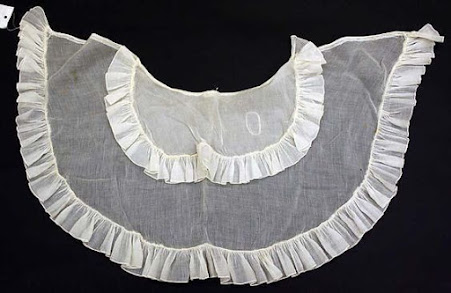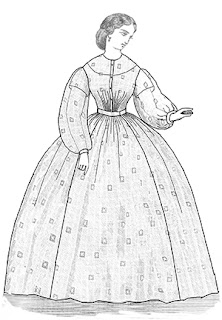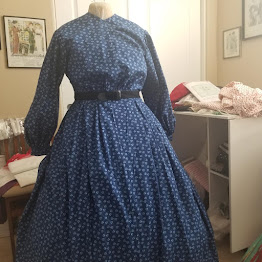What do you do when you don’t feel like sewing, or have any enthusiasm to even try?
You plan. So, I’m just going to show you some pretty
pictures and fabrics, and that will have to suffice for now. Who knows, it may
inspire me to do something. No promises but maybe some baby steps.
While my
1860s Project has fizzled (in truth, I am doing some cartridge pleating on the 3
skirts but haphazardly), I went forward on planning my 1830s Project of cutting
and sewing 3-4-5, maybe 6, at a time. I’m undecided at this point which of my
plaid silk taffetas I want to attack first, so it may just be 4.
First thing
I did was gather all my dress photos that I wanted to make and decided what
style to do. I’ve done about 4 of the pleated front bodices, so I want to try a
crossover style, and a V-neck style. I’m a little tired of the off-the-shoulder
styles. AND I want to be able to close them IN FRONT!!
Oh heck, let’s just throw in a mourning dress, and maybe an archery dress, although I don’t do archery but I can carry an arrow around with me.

It’s the necklines that are going to confound me. I’ve got a couple different patterns I haven’t used yet but none are quite what I want, so it’s going to take some altering.
This Period Impressions pattern 1837 Day dress has a front seam that could be changed to be opened, and it’s got those cute sleeve finishes. Past Patterns #806 Lowell Mill Dress, also has cute sleeves and I bet I could change the front to a front closure but don’t like that straight neckline.
Surprisingly this Butterick 5832, which was copied off an 1841 extant dress, could be used for the V-neckline. I haven’t pulled out the pattern yet so I don’t know if it’s actually pleated in front or if that’s an overlay. And I might be able to extend it to make it a crossover, like this 1838 extant dress. It’s got cute sleeves too. Then someone pointed out View C on this Laughing Moon pattern #103 that has a crossover bodice that might help in my construction, even though its 1890s. As more ideas come in for doing this, the more excited I get. It takes a bit of the scary out of it.
Speaking of scary; I keep saying
I want to make those gathered/smocked sleeves but when it comes right down to
it, they look scary. I haven’t found any directions yet how they do those. I’m
assuming you cut out the humongous sleeve, then cartridge-pleat/smock wherever you want
it, either from the shoulders down, or mid-upper arm, then sew the sleeve seams
together. Inquiring minds want to know. I don’t know of anyone who’s tried them
yet. I think possibly just gathering them down and putting a ruffle around the
bottom might work too. This extant dress shows off the smocking very well. I
would also LOVE to find fabric like that. I can’t believe how brilliantly
colorful it still is.
These antique ones would be good shapes to try also. Its easier to add ruffles to these than to find an embroidered fabric you could use.
I ran across this one on Pinterest. It has a wide ruffle but finished with a delicate lace trim.
These two are interesting, both from 1837, and the longer one would be fun.
The trick to making these is to shape the pattern to have a curved neck. Otherwise it bunches up around your neck. This photo of the one I own shows that shape. I’ve since done a repair on the little tear with as tiny stitches as I could possibly do, so it wouldn’t tear further. I only wear it for short periods of time, or for fashion shows.
I
may have some extra fine cotton voile in my stash somewhere to get started on
one of these. And the easiest one to start would be using the pattern I made
off of my antique one. Small hand projects seems to be the way to go these days
as they don’t seem to be too overwhelming. I’ve still been hand sewing 18th
C kerchiefs and selling them almost as soon as I post one, so I’d like to give
the 1830s ones a try too.




































